
Devil's club or Devil's walking stick is a large understory shrub native to the rainforests of the Pacific Northwest, but also disjunct on islands in Lake Superior. It is noted for its large palmate leaves and erect, woody stems covered in noxious and irritating spines. It is also known as Alaskan ginseng and similar names, although it is not a true ginseng.

Artemisia is a large, diverse genus of plants belonging to the daisy family Asteraceae, with almost 500 species. Common names for various species in the genus include mugwort, wormwood, and sagebrush.
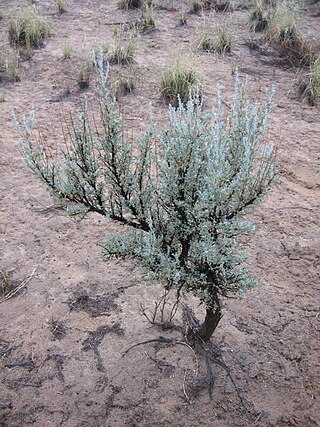
Artemisia tridentata, commonly called big sagebrush, Great Basin sagebrush or simply sagebrush, is an aromatic shrub from the family Asteraceae.

Arnica is a genus of perennial, herbaceous plants in the sunflower family (Asteraceae). The genus name Arnica may be derived from the Greek arni, "lamb", in reference to the plants' soft, hairy leaves. Arnica is also known by the names mountain tobacco and, confusingly, leopard's bane and wolfsbane—two names that it shares with the entirely unrelated genus Aconitum.

Artemisia abrotanum, the southernwood, lad's love, or southern wormwood, is a species of flowering plant in the sunflower family. It is native to Eurasia and Africa but naturalized in scattered locations in North America. Other common names include: old man, boy's love, oldman wormwood, lover's plant, appleringie, garderobe, Our Lord's wood, maid's ruin, garden sagebrush, European sage, sitherwood and lemon plant.
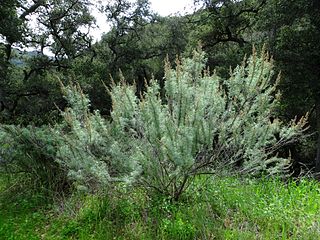
Artemisia californica, also known as California sagebrush, is a species of western North American shrub in the sunflower family.
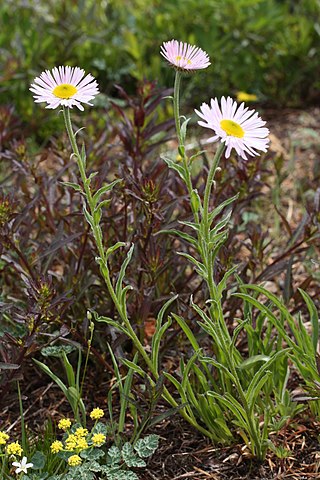
Erigeron peregrinus is a North American species of flowering plants in the family Asteraceae known by the common name wandering fleabane.

Artemisia campestris is a common and widespread species of plants in the sunflower family, Asteraceae. It is native to a wide region of Eurasia and North America. Common names include field wormwood, beach wormwood, northern wormwood, Breckland wormwood, boreal wormwood, Canadian wormwood, field sagewort and field mugwort.
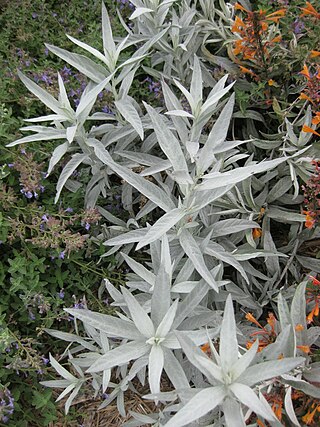
Artemisia ludoviciana is a North American species of flowering plant in the daisy family Asteraceae, known by several common names, including silver wormwood, western mugwort, Louisiana wormwood, white sagebrush, lobed cud-weed, prairie sage, and gray sagewort.

Artemisia biennis is a species of sagebrush known by the common name biennial wormwood. It is a common and widely distributed weed, so well established in many places that its region of origin is difficult to ascertain. This species is most likely native to northwestern North America and naturalized in Western Europe, and eastern and southern North America.

Artemisia nova is a North American species of sagebrush, known by the common name black sagebrush. It is "one of the most common shrubs in the western United States".

Artemisia palmeri is a rare species of sagebrush known by the common names San Diego sagewort and Palmer sagewort.

Artemisia suksdorfii is a North American species of sagebrush in the sunflower family. It is known by the common names coastal mugwort, coastal wormwood, and Suksdorf sagewort. It is native to coastal regions from British Columbia, Washington, Oregon, and northern California as far south as Sonoma County, with isolated populations on Santa Catalina Island in Los Angeles County.

Artemisia cana is a species of sagebrush native to western and central North America; it is a member of the sunflower family. It is known by many common names, including silver sagebrush, sticky sagebrush, silver wormwood, hoary sagebrush, and dwarf sagebrush.

Artemisia norvegica is a species of flowering plant in the aster family known by the common names alpine sagewort, boreal sagewort, mountain sagewort, Norwegian mugwort, arctic wormwood, and spruce wormwood. It is found in cold locations in Eurasia and high altitudes and high latitudes in North America.

Artemisia filifolia, known by common names including sand sagebrush, sand sage and sandhill sage, is a species of flowering plant in the aster family. It is native to North America, where it occurs from Nevada east to South Dakota and from there south to Arizona, Chihuahua, and Texas.
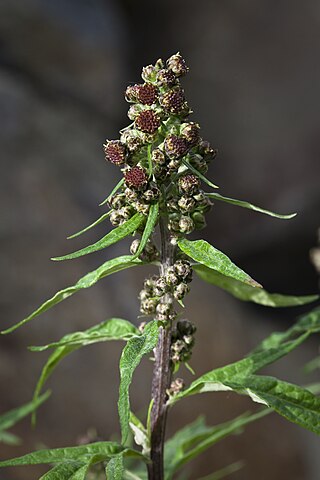
Artemisia tilesii is an Asian and North American species of flowering plant in the aster family. Its common names include Tilesius' wormwood, Aleutian mugwort, and stinkweed. It is native to Russia, Japan, and northern North America.

Artemisia stelleriana is an Asian and North American species of plants in the sunflower family. It is native to China, Japan, Korea, Russian Far East, and the Aleutian Islands in the United States. The species is widely cultivated as an ornamental and naturalized in scattered locations in North America, primarily on coastal dunes and other sandy locations, as well as in Scandinavia. Common names include hoary mugwort, Dusty Miller, beach wormwood, and oldwoman.
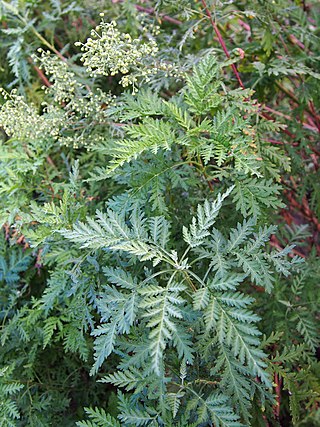
Artemisia gmelinii, also known as Artemisia sacrorum is a perennial shrub in the family Asteraceae. It is commonly known as Russian wormood or Gmelin's wormwood.

Artemisia laciniata is a species of wormwood in the family Asteraceae. Its common name is the Siberian wormwood. It is mostly found in Russia, Alaska, the Yukon, and other parts of the US and Europe.




















